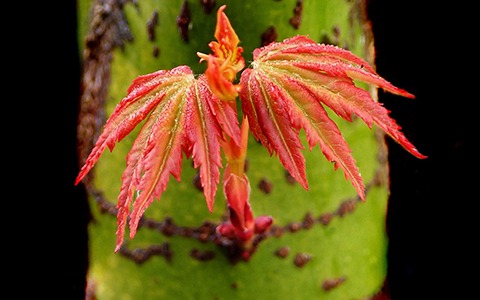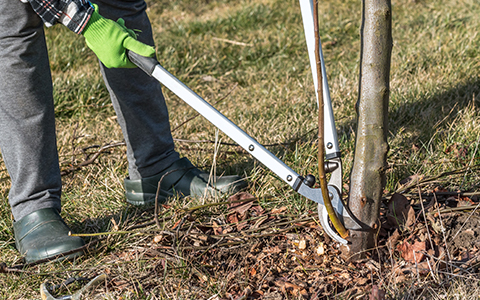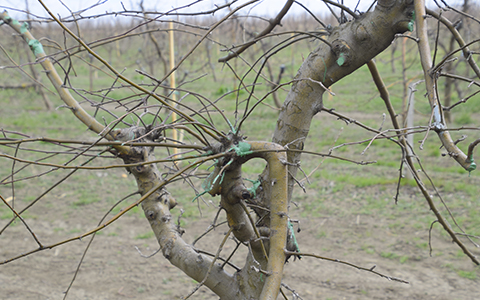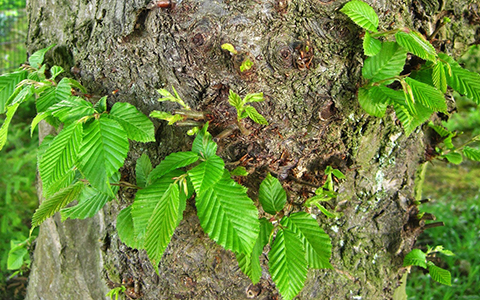Notice: Undefined variable: page in /home/vrxdg1855sn3/public_html/wp-content/themes/72tree/content.php on line 15
Notice: Trying to get property 'ID' of non-object in /home/vrxdg1855sn3/public_html/wp-content/themes/72tree/content.php on line 15
Controlling and Removing Tree Suckers

Prevent your trees from being weakened by suckers and watersprouts stealing their water and nutrients. Knowing how and when to remove tree suckers will help you keep your tree healthy and thriving.
72tree.com gathered the following information about tree sucker and water sprout removal, the damages they cause trees, and how to properly control them.
Removing Tree Suckers
Allowing suckers to remain on your tree will only divert water and nutrients from the vegetative and fruiting wood that needs to grow strong and healthy. Suckers should be removed when they appear, and they will grow very quickly.
Suckers grow from the base of the trunk or from roots and will need to be removed manually. Ideally, they should be pruned back to the point where they emerge from a root or base of the tree. Consider the following:
• Using a hand trowel, expose the sucker to the area where it emerged from the root.
• Snip or cut it off at the base with a sharp pair of garden shears (leave the collar, where the tree sucker meets the tree, to help speed wound recovery)
• Cover the cut area (with soil) and allow it to heal
• Repeat this process for any other suckers
Avoid mowing these growths. Mowing activities can cause abnormal growth, and damaged growth can become a vector for disease and infestation.

Tip: Leaving a stub can make the problem worse by causing multiple shoots to form. You will need to dig to get to where suckers emerge from roots.
Note: Once suckers start developing on a tree, they will usually continue to occur for the rest of that tree’s life and will need to be removed regularly.
Removing Watersprouts
Watersprouts like suckers are fast-growing and tend to grow vertically, either from the trunk or from an existing branch. They, too, divert water and nutrients from the tree, block sunlight and air circulation. Here’s how to remove them:
• Identify watersprouts as being unnecessary growth to be pruned away
• Use pruning shears to cut them from the tree
• Cut them back to their point of emergence from the trunk/branch (again, leaving the collar, where the watersprout meets the tree, to accelerate wound recovery)
• Allow these wounds to heal like other pruning wounds
Tip: leaving a stub when removing watersprouts can make the problem worse by causing multiple shoots to form.
What Causes Tree Suckers and Watersprouts
When trees are stressed or have suffered trauma, they often respond by producing upright shoots called water sprouts and suckers. Here are some of the occurrences that can cause them to grow:

• Root Damage
• Root Loss
• Storm Damage
• Branch Loss
• Topping
• Over/Improper Pruning
• Pruning Suckers
• Disease
• Drought
• Infestation
• Mower/Mechanical Damage
Note: Suckers and watersprouts can be a sign of a tree’s aging. Many trees will sucker as they grow old and start to decay or even die.
Water sprouts and suckers grow from dormant buds in the bark and/or roots and are flimsily attached to trees unless allowed to grow for many seasons.
Tip: Once you detect a problem with suckers and watersprouts, hire an arborist to evaluate the health of your tree(s).
Tree Sucker and Watersprout Control

There are products containing Napthalene Acetic Acid (NAA) labeled to control sprouts on certain trees. Research must still be done on their effectiveness with landscape trees.
Products similar to Bonide’s “Sucker Punch” have a water-based paraffin wax emulsion, so once it is applied, it will last for up to 6 months.
Similarly, some herbicides are effective at controlling and suppressing suckers but are not recommended for all plant or tree varieties. Likewise, herbicides applied to suckers can severely harm the tree. Such products should be applied by a certified arborist.
One of the best ways to prevent water sprouts and suckers on your trees is to keep them as healthy as possible with proper care and pruning. If your trees already have multiple sprouts, do your best to figure out (or call in a professional) to find out what is causing the stress and strategize to correct it.
Tree Suckers and Watersprouts
In this article, you discovered information about tree suckers and watersprouts, what damages they can do to your trees, and how to properly remove them.
Knowing why suckers and watersprouts grow on trees will help you determine if there is more severe damage occurring within the tree or what steps should be taken to increase the tree’s vigor.
Ignoring a problem with watersprouts and suckers can make a troubled tree even further from recovery. As time passes, your tree’s water and nutrients can become severely depleted, leading to more tree problems, infections, infestations, and eventual death.
Sources:
extension.unh.edu/blog/can-water-sprouts-and-suckers-be-prevented-trees
newswire.caes.uga.edu/story/5514/Root-Suckers.html
hyg.ipm.illinois.edu/article.php?id=993
hort.ifas.ufl.edu/woody/cleaning.shtml
